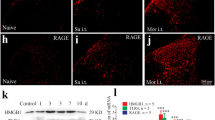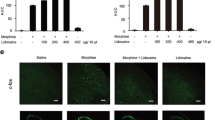Abstract
Nuclear factor kappa B (NF-κB) in the spinal cord is involved in pro-inflammatory cytokine-mediated pain facilitation. However, the role of NF-κB activation in chronic morphine-induced analgesic tolerance and the underlying mechanisms remain unclear. In the present study, we found that the level of phosphorylated NF-κB p65 (p-p65) was increased in the dorsal horn of the lumbar 4–6 segments after intrathecal administration of morphine for 7 consecutive days, and the p-p65 was co-localized with neurons and astrocytes. The expression of TNF-α and IL-1β was also increased in the same area. In addition, pretreatment with pyrrolidinedithiocarbamate (PDTC) or SN50, inhibitors of NF-κB, prevented the development of morphine analgesic tolerance and alleviated morphine withdrawal-induced allodynia and hyperalgesia. The increase in TNF-α and IL-1β expression induced by chronic morphine exposure was also partially blocked by PDTC pretreatment. In another experiment, rats receiving PDTC or SN50 beginning on day 7 of morphine injection showed partial recovery of the anti-nociceptive effects of morphine and attenuation of the withdrawal-induced abnormal pain. Meanwhile, intrathecal pretreatment with lipopolysaccharide from Rhodobacter sphaeroides, an antagonist of toll-like receptor 4 (TLR4), blocked the activation of NF-κB, and prevented the development of morphine tolerance and withdrawal-induced abnormal pain. These data indicated that TLR4-mediated NF-κB activation in the spinal cord is involved in the development and maintenance of morphine analgesic tolerance and withdrawal-induced pain hypersensitivity.
Similar content being viewed by others
References
Bekhit MH. Opioid-induced hyperalgesia and tolerance. Am J Ther 2010, 17: 498–510.
Mao J, Price DD, Mayer DJ. Mechanisms of hyperalgesia and morphine tolerance: a current view of their possible interactions. Pain 1995, 62: 259–274.
Lopez-Gimenez JF, Milligan G. Opioid regulation of mu receptor internalisation: relevance to the development of tolerance and dependence. CNS Neurol Disord Drug Targets 2010, 9: 616–626.
Chen YL, Law PY, Loh HH. Nuclear factor kappaB signaling in opioid functions and receptor gene expression. J Neuroimmune Pharmacol 2006, 1: 270–279.
Ghosh S, Karin M. Missing pieces in the NF-kappaB puzzle. Cell 2002, 109: S81–96.
Li Q, Verma IM. NF-kappaB regulation in the immune system. Nat Rev Immunol 2002, 2: 725–734.
Mattson MP. Insulating axons via NF-kappaB. Nat Neurosci 2003, 6: 105–106.
Mattson MP. NF-kappaB in the survival and plasticity of neurons. Neurochem Res 2005, 30: 883–893.
Kaltschmidt B, Kaltschmidt C. NF-kappaB in the nervous system. Cold Spring Harb Perspect Biol 2009, 1: a001271.
Fu ES, Zhang YP, Sagen J, Candiotti KA, Morton PD, Liebl DJ, et al. Transgenic inhibition of glial NF-kappa B reduces pain behavior and inflammation after peripheral nerve injury. Pain 2010, 148: 509–518.
Ledeboer A, Gamanos M, Lai W, Martin D, Maier SF, Watkins LR, et al. Involvement of spinal cord nuclear factor kappaB activation in rat models of proinflammatory cytokine-mediated pain facilitation. Eur J Neurosci 2005, 22: 1977–1986.
Niederberger E, Geisslinger G. The IKK-NF-kappaB pathway: a source for novel molecular drug targets in pain therapy? FASEB J 2008, 22: 3432–3442.
Tegeder I, Niederberger E, Schmidt R, Kunz S, Guhring H, Ritzeler O, et al. Specific Inhibition of IkappaB kinase reduces hyperalgesia in inflammatory and neuropathic pain models in rats. J Neurosci 2004, 24: 1637–1645.
Zang Y, He XH, Xin WJ, Pang RP, Wei XH, Zhou LJ, et al. Inhibition of NF-kappaB prevents mechanical allodynia induced by spinal ventral root transection and suppresses the re-expression of Nav1.3 in DRG neurons in vivo and in vitro. Brain Res 2010, 1363: 151–158
Watkins LR, Hutchinson MR, Johnston IN, Maier SF. Glia: novel counter-regulators of opioid analgesia. Trends Neurosci 2005, 28: 661–669.
Wen YR, Tan PH, Cheng JK, Liu YC, Ji RR. Microglia: a promising target for treating neuropathic and postoperative pain, and morphine tolerance. J Formos Med Assoc 2011, 110: 487–494.
Hutchinson MR, Coats BD, Lewis SS, Zhang Y, Sprunger DB, Rezvani N, et al. Proinflammatory cytokines oppose opioidinduced acute and chronic analgesia. Brain Behav Immun 2008, 22: 1178–1189.
Shen CH, Tsai RY, Wong CS. Role of neuroinflammation in morphine tolerance: effect of tumor necrosis factor-alpha. Acta Anaesthesiol Taiwan 2012, 50: 178–182.
Berta T, Liu T, Liu YC, Xu ZZ, Ji RR. Acute morphine activates satellite glial cells and up-regulates IL-1beta in dorsal root ganglia in mice via matrix metalloprotease-9. Mol Pain 2012, 8: 18.
Johnston IN, Milligan ED, Wieseler-Frank J, Frank MG, Zapata V, Campisi J, et al. A role for proinflammatory cytokines and fractalkine in analgesia, tolerance, and subsequent pain facilitation induced by chronic intrathecal morphine. J Neurosci 2004, 24: 7353–7365.
Wang X, Douglas SD, Commons KG, Pleasure DE, Lai J, Ho C, et al. A non-peptide substance P antagonist (CP-96,345) inhibits morphine-induced NF-kappa B promoter activation in human NT2-N neurons. J Neurosci Res 2004, 75: 544–553.
Zimmermann M. Ethical guidelines for investigations of experimental pain in conscious animals. Pain 1983, 16: 109–110.
Storkson RV, Kjorsvik A, Tjolsen A, Hole K. Lumbar catheterization of the spinal subarachnoid space in the rat. J Neurosci Methods 1996, 65: 167–72.
Lim G, Wang S, Zeng Q, Sung B, Yang L, Mao J. Expression of spinal NMDA receptor and PKCgamma after chronic morphine is regulated by spinal glucocorticoid receptor. J Neurosci 2005, 25: 11145–11154.
Li Y, Zhang H, Zhang HM, Kosturakis AK, Jawad AB, Dougherty PM. Toll-Like Receptor 4 Signaling Contributes to Paclitaxel-Induced Peripheral Neuropathy. J Pain 2014, 15: 712–725.
Xu JT, Zhao JY, Zhao X, Ligons D, Tiwari V, Atianjoh FE, et al. Opioid receptor-triggered spinal mTORC1 activation contributes to morphine tolerance and hyperalgesia. J Clin Invest 2014, 124: 592–603.
Xu JT, Xin WJ, Zang Y, Wu CY, Liu XG. The role of tumor necrosis factor-alpha in the neuropathic pain induced by Lumbar 5 ventral root transection in rat. Pain 2006, 123: 306–321.
Chaplan SR, Bach FW, Pogrel JW, Chung JM, Yaksh TL. Quantitative assessment of tactile allodynia in the rat paw. J Neurosci Methods 1994, 53: 55–63.
Hargreaves K, Dubner R, Brown F, Flores C, Joris J. A new and sensitive method for measuring thermal nociception in cutaneous hyperalgesia. Pain 1988, 32: 77–88.
Xu JT, Zhao X, Yaster M, Tao YX. Expression and distribution of mTOR, p70S6K, 4E-BP1, and their phosphorylated counterparts in rat dorsal root ganglion and spinal cord dorsal horn. Brain Res 2010, 1336: 46–57.
Hutchinson MR, Zhang Y, Shridhar M, Evans JH, Buchanan MM, Zhao TX, et al. Evidence that opioids may have toll-like receptor 4 and MD-2 effects. Brain Behav Immun 2010, 24: 83–95
Hameed H, Hameed M, Christo PJ. The effect of morphine on glial cells as a potential therapeutic target for pharmacological development of analgesic drugs. Curr Pain Headache Rep 2010, 14: 96–104.
Hutchinson MR, Bland ST, Johnson KW, Rice KC, Maier SF, Watkins LR. Opioid-induced glial activation: mechanisms of activation and implications for opioid analgesia, dependence, and reward. ScientificWorldJournal 2007, 7: 98–111.
Raghavendra V, Rutkowski MD, DeLeo JA. The role of spinal neuroimmune activation in morphine tolerance/hyperalgesia in neuropathic and sham-operated rats. J Neurosci 2002, 22: 9980–9989.
Merighi S, Gessi S, Varani K, Fazzi D, Stefanelli A, Borea PA. Morphine mediates a proinflammatory phenotype via mu-opioid receptor-PKCvarepsilon-Akt-ERK1/2 signaling pathway in activated microglial cells. Biochem Pharmacol 2013, 86: 487–496.
Verge GM, Milligan ED, Maier SF, Watkins LR, Naeve GS, Foster AC. Fractalkine (CX3CL1) and fractalkine receptor (CX3CR1) distribution in spinal cord and dorsal root ganglia under basal and neuropathic pain conditions. Eur J Neurosci 2004, 20:1150–1160.
Milligan ED, Sloane EM, Watkins LR. Glia in pathological pain: a role for fractalkine. J Neuroimmunol 2008, 198: 113–120.
Viatour P, Merville MP, Bours V, Chariot A. Phosphorylation of NF-kappaB and IkappaB protein. implications in cancer and inflammation. Trends Biochem Sci 2005, 30: 43–52.
Vermeulen L, De WG, Notebaert S, Vanden BW, Haegeman G. Regulation of the transcriptional activity of the nuclear factor-kappaB p65 subunit. Biochem Pharmacol 2002, 64: 963–970.
Schreck R, Meier B, Mannel DN, Droge W, Baeuerle PA. Dithiocarbamates as potent inhibitors of nuclear factor kappa B activation in intact cells. J Exp Med 1992, 175: 1181–1194.
Lin YZ, Yao SY, Veach RA, Torgerson TR, Hawiger J. Inhibition of nuclear translocation of transcription factor NFkappa B by a synthetic peptide containing a cell membranepermeable motif and nuclear localization sequence. J Biol Chem 1995, 270: 14255–14258.
Liou HC. Regulation of the immune system by NF-kappaB and IkappaB. J Biochem Mol Biol 2002, 35: 537–546.
Ye RD. Regulation of nuclear factor kappaB activation by G-protein-coupled receptors. J Leukoc Biol 2001, 70: 839–848.
El-Hage N, Bruce-Keller AJ, Yakovleva T, Bazov I, Bakalkin G, Knapp PE, et al. Morphine exacerbates HIV-1 Tat-induced cytokine production in astrocytes through convergent effects on [Ca(2+)](i), NF-kappaB trafficking and transcription. PLoS One 2008, e4093.
Sawaya BE, Deshmane SL, Mukerjee R, Fan S, Khalili K. TNF alpha production in morphine-treated human neural cells is NF-kappaB-dependent. J Neuroimmune Pharmacol 2009, 4:140–149.
Liu S, Liu YP, Song WB, Song XJ. EphrinB-EphB receptor signaling contributes to bone cancer pain via Toll-like receptor and proinflammatory cytokines in rat spinal cord. Pain 2013, 154: 2823–2835.
Author information
Authors and Affiliations
Corresponding authors
Rights and permissions
About this article
Cite this article
Bai, L., Zhai, C., Han, K. et al. Toll-like receptor 4-mediated nuclear factor-κB activation in spinal cord contributes to chronic morphine-induced analgesic tolerance and hyperalgesia in rats. Neurosci. Bull. 30, 936–948 (2014). https://doi.org/10.1007/s12264-014-1483-7
Received:
Accepted:
Published:
Issue Date:
DOI: https://doi.org/10.1007/s12264-014-1483-7




